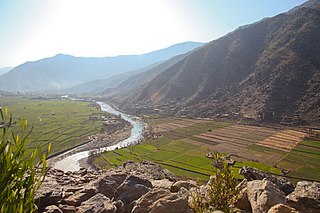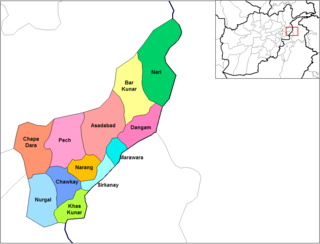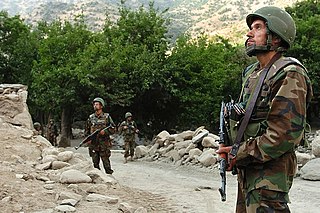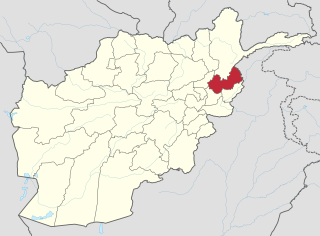
Kāfiristān, or Kāfirstān, is a historical region that covered present-day Nuristan Province in Afghanistan and its surroundings. This historic region lies on, and mainly comprises, the basins of the rivers Alingar, Pech (Kamah), Landai Sin river and Kunar, and the intervening mountain ranges. It is bounded by the main range of the Hindu Kush on the north, Pakistan's Chitral District to the east, the Kunar Valley in the south and the Alishang River in the west.

Afghanistan is divided into 34 provinces. The provinces of Afghanistan are the primary administrative divisions. Each province encompasses a number of districts or usually over 1,000 villages.

The Nuristanis are an ethnic group native to the Nuristan Province of northeastern Afghanistan and Chitral District of northwestern Pakistan. Their languages comprise the Nuristani branch of Indo-Iranian languages.

Nuristan, also spelled as Nurestan or Nooristan, is one of the 34 provinces of Afghanistan, located in the eastern part of the country. It is divided into seven districts and is Afghanistan's least populous province, with a population of around 167,000. Parun serves as the provincial capital. Nuristan is bordered on the south by Laghman and Kunar provinces, on the north by Badakhshan province, on the west by Panjshir province, and on the east by Pakistan.

Kunar is one of the 34 provinces of Afghanistan, located in the northeastern part of the country. Its capital is Asadabad. Its population is estimated to be 508,224. Kunar's major political groups include Wahhabis or Ahl-e- Hadith, Nazhat-e Hambastagi Milli, Hezb-e Afghanistan Naween, Hezb-e Islami Gulbuddin.

Sunni Islam (Hanafi/Deobandi) is the largest and the state religion of the Islamic Emirate of Afghanistan. According to The World Factbook, Sunni Muslims constitute between 84.7 and 89.7% of the population, and Shia Muslims between 10 and 15%. Other religions are followed by 0.3% of the population.

Chapa Dara District is situated in the western part of Kunar Province, Afghanistan and borders Nuristan Province. The population is 27,500 (2006). The district consists of a mountainous terrain. The capital of the district is Chapa Dara.
Mohammad Tamim Nuristani is a businessman and politician from Nuristan Province of Afghanistan. Mohammad Tamim was the previous governor of Nuristan Province and replaced by Hafiz Abdul Qayyum.

The Battle of Kamdesh took place during the war in Afghanistan. It occurred on October 3, 2009, when a force of 300 Taliban assaulted the American Combat Outpost ("COP") Keating near the town of Kamdesh in Nuristan Province in eastern Afghanistan. The attack was the bloodiest battle for US forces since the Battle of Wanat in July 2008, which occurred 20 miles (32 km) away from Kamdesh. The attack on COP Keating resulted in 8 Americans killed and 27 wounded while the Taliban suffered 150–200 killed.

Parun, also called Prasûn and Prasungul, is a small town and administrative center of Nuristan Province and its Parun District in Afghanistan.

Jamaludin Badr served as Governor of Nuristan Province, Afghanistan from 2009 to 2011. He is the successor of Eng. Hazrat Din Noor, who died in a car accident only a few months after he was installed.

On 5 August 2010, ten members of International Assistance Mission (IAM) Nuristan Eye Camp team were killed in Kuran wa Munjan District of Badakhshan Province in Afghanistan. The team was attacked as it was returning from Nuristan to Kabul. One team member was spared while the rest of the team were killed immediately. Those killed were six Americans, two Afghans, one Briton and one German.

Bargi Matal District is a district of Nuristan Province, Afghanistan. It was originally in Konarha Province and then was moved to the newly created Nuristan Province in 2001.

Nurgaram District, also known as Nechegram in all Nuristani languages and Neishigram in Waigali, is a district of Nuristan Province in Afghanistan, which was established in the 2004 Afghanistan administrative reorganization out of parts of Nuristan District and Wama District.
Mandol District is a district of Nuristan Province in eastern Afghanistan. It was originally in Laghman Province and then was moved to the newly created Nuristan Province in 2001.

The Kashmir musk deer is an endangered species of musk deer native to Afghanistan, India, and Pakistan. It was originally described as a subspecies to the alpine musk deer, but is now classified as a separate species. It stands at 60 cm (24 in) tall, and only males have tusks which they use during mating season to compete for females.

Flooding began in the Kamdesh District in Nuristan, Afghanistan, due to heavy rains. As of July 31, the death toll is at 113 while the number of people missing is unknown. According to Taliban spokesman Zabihullah Mujahed, heavy rain on July 28 caused the flooding.

Nuristan National Park is a national park in Afghanistan announced by the Government of Afghanistan on 5 June 2020, making it the third in the country after Band-e Amir National Park and Wakhan National Park. The Park comprises the entire mountainous eastern Province of Nuristan, which borders Pakistan. According to the FAO, a detailed management plan - and "gazettement" - is still forthcoming.























